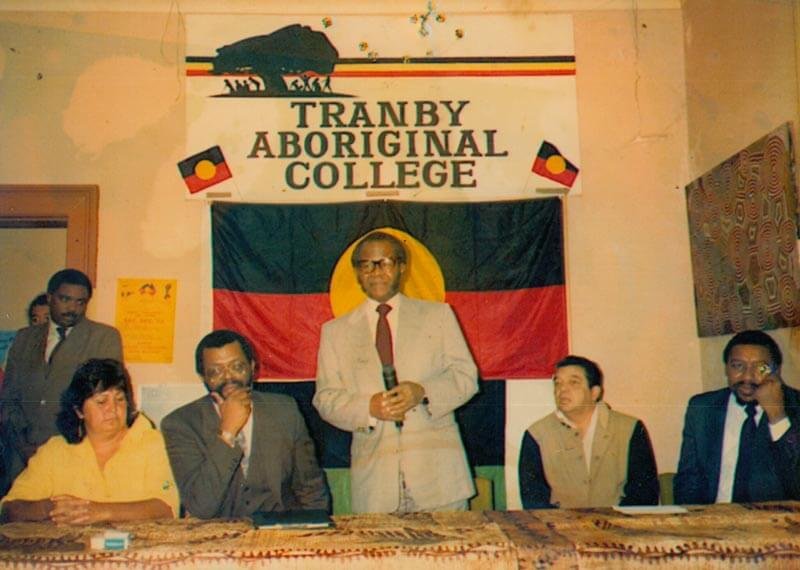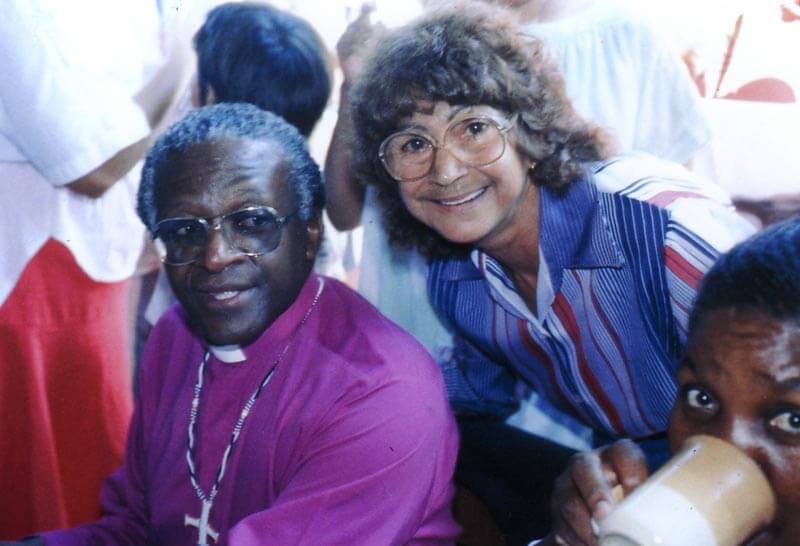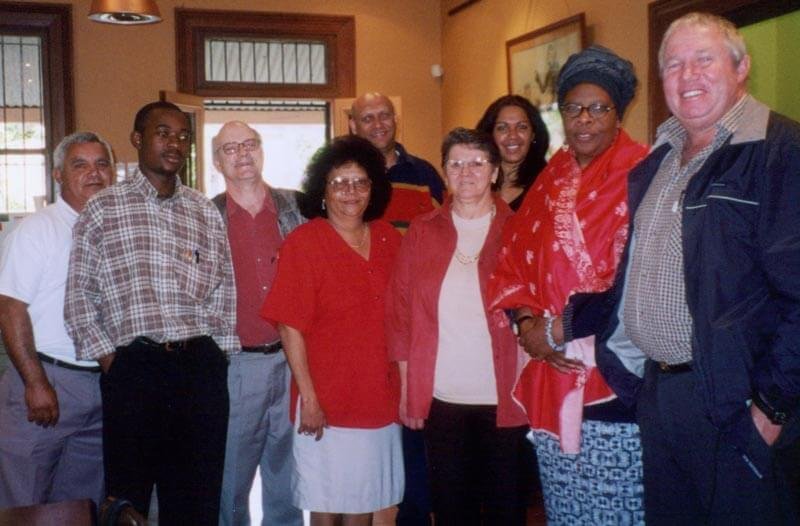LEARNING IN activism | Building alliances
South Africa + Zimbabwe
The struggle against colonialism in Southern Africa had many links to the struggles of Aboriginal people in Australia. The colonisers were European and largely the same: in South Africa it was the British along with the Dutch and in Rhodesia it was just the British. The South African separation and discrimination by race called Apartheid had many similarities with segregation and dispossession in Australia – and was said to have been modelled on Australian legislation (the Queensland Act). Many white South Africans migrated to Australia, because the ‘White Australia’ policy allowed them to expect a similarly racist approach to nationhood.
Aboriginal support for the struggle to end Apartheid in South Africa and colonialism in Rhodesia (Zimbabwe) aimed to build alliances across the region – but it was also about making links with people living in Australia.
Some southern Africans – white and black – had come to Australia to get away from Apartheid and colonial racism. Others came to study: Sekai, a Zimbabwean, studied at the Australian National University in the early 1970s – and met her future husband there, Jim Holland, an Australian who later became an engineer in the early 1960s. Both Sekai and Jim took an active role in trying to make Australia into a more just society. Sekai became a construction worker, one of the earliest women to do so, and joined the Builders Labourers’ Federation – where Kevin was an organiser. During this time, Sekai and Jim developed close relations with many Aboriginal activists and took part in the campaigns for justice and Land Rights.
The South African government gained much international credibility from the many international sporting tours undertaken by its sporting teams - to which only white sportsmen were ever selected. When South Africa sent a team of surf-life savers to a competition in Australia in March 1971, Sekai, Jim and many of the Builders Labourers wanted to stop the tour to send the message that Apartheid was not acceptable. They were joined by many Australians who opposed racism, forming the Anti-Apartheid movement. All of them found that the Australian government considered them a danger, with the Australian Security Organisation, ASIO, keeping them under close watch. A series of major protests at the Springboks Rugby Union games later in 1971 ensured that the planned South African cricket tour later in the year had to be cancelled. Aboriginal people took part in these demonstrations to end Apartheid.
In 1973, Kevin Cook, still an organiser in the NSW BLF, had met Herbert Chitepo on his speaking tour to Australia. Chitepo was a leading Zimbabwean campaigner for independence and spoke on this tour to unionists, on public radio and at universities in Sydney and Canberra. He was assassinated by supporters of Robert Mugabe in 1975, prior to Mugabe’s seizure of power.
After the Federal Government’s destruction of the NSW BLF in 1975, Kevin became a student at Tranby in Co-operative Studies and Community Studies. In 1979, he was supported by Tranby to study for six months at the Coady Institute for Co-operative Studies in Canada. In that Coady course, there were many people from movements all over the world who wanted to strengthen their communities so they could defend themselves against racism and colonialism. Under Apartheid laws in South Africa, Africans were forbidden from forming political parties or unions, but they were permitted to take part in co-operatives. There were therefore many South Africans who attended the Coady Institute of Cooperative Studies who were also strong campaigners against Apartheid, and supporters of the African National Congress. Kevin met activist South Africans and Zimbabwans there and kept in touch with them for the rest of his life.
Graduation photograph at Coady Institute, 1979, showing Kevin (front row, third from right) and the many Africans and other community activists who attended the Community Development course he took.
After Kevin became the General Secretary of Tranby Co-op, in 1980, he enabled many South Africans and Zimbabwean activists to speak to students and friends at Tranby whenever they came to Australia.
Oliver Tambo speaking at Tranby around 1987. Those on the platform include Delia Lowe, a Tranby Board member from Roseby Park and Eddie Funde, (right) representative of the ANC in Australia.
When Nelson Mandela was finally released from prison in February 1990, one of the first places he visited to talk to supporters was Sydney, in October 1990. His goal was to continue his long campaign for an end to Apartheid and the achievement of majority rule in South Africa. Tranby representatives were invited to meet Nelson Mandela as a result of Tranby’s long support for the anti-Apartheid struggle. Apartheid finally came to an end in 1994, and Nelson Mandela was elected South African President. Tranby maintained close contact with those who continued to work for justice in South Africa and globally. One of the most tenacious and best-known campaigners was Bishop Desmond Tutu, who came to Australia and visited Tranby in 1993 in order to meet Indigenous people and to talk with supporters of the long struggles for justice and equality.
Desmond Tutu with William Bates, from Wilcannia, land rights campaigner and legal advocate
Desmond Tutu at Tranby with Joyce Williams, community activist from Wellington
Desmond Tutu with Kevin Tory (TUCAR) at Tranby.
Desmond Tutu speaking in the dining room at Tranby.
Sekai Holland returned to her country - now the independent nation of Zimbabwe but still ruled by Robert Mugabe – and she stayed in close contact with supporters in Australia. She returned to Australia a number of times, setting up the Zimbabwe Information Centre (ZIC) in 1991 to maintain communication with Australian supporters. To try to make Zimbabwe a more democratic and just country, Sekai stood for election and become a member of the Zimbabwean parliament, in opposition to the ruling Mugabe government. Because of her outspoken and tenacious calls for justice and reform, Sekai was harassed, arrested and finally tortured by the Zimbabwean government. She helped found the party known as the Movement for Democratic Change (MDC), led for many years by her colleague, Morgan Tsvangirai. In 2001, Sekai led a delegation to Australia to build further awareness of the work the MDC was doing inside Zimbabwe. This MDC delegation came to Sydney and met with Aboriginal supporters at Tranby.
MDC Delegation meeting at Tranby, 2001, with Indigenous supporters. Photograph includes, from left, Indigenous supporter (unnamed), Nelson Chamisa (now leader of MDC), Peter Murphy (ZIC), Yvonne de Vries (Tranby Director of Studies), Indigenous supporter (unnamed), Judy Chester (Tranby ADU and PSU), Tranby student (unnamed), Sekai Holland and, on right, Roy Bennett, an MDC MP.
Sekai Holland pictured recently during a visit to Australia.
Tranby has continued to remain in contact with and in support of democratic movements in South Africa and Zimbabwe, hosting Sekai on the occasions of her return visits to see her children in Australia.
1971 National Aborigines Day, Sydney Town Hall. Beginning of the Journey for Justice, in which demonstrators walked to Queensland calling for Land Rights and full civil rights for Indigenous people. Aboriginal demonstrators shown on upper steps include Lester Bostock (closely associated with Tranby), Gary Williams, Lyn Craigie (then Thompson). Sekai Holland can be seen towards the right at the back of the stairs, with a headdress, holding the sign saying: ‘Aboriginal Land Now’. Source: SMH, 10 July 1971, picture courtesy Fairfax Media
Anti-Apartheid demonstration photograph from ASIO archives, showing numbers on those people on whom ASIO was keeping a personal record
Gary Foley, Billy Craigie and Lyn Thompson (pregnant with her daughter Yeena) in Springbok jerseys – liberated from the white South African rugby team! The South African Prime Minister B.J. Vorster had said ‘A black man will never wear a Springbok jersey’.











